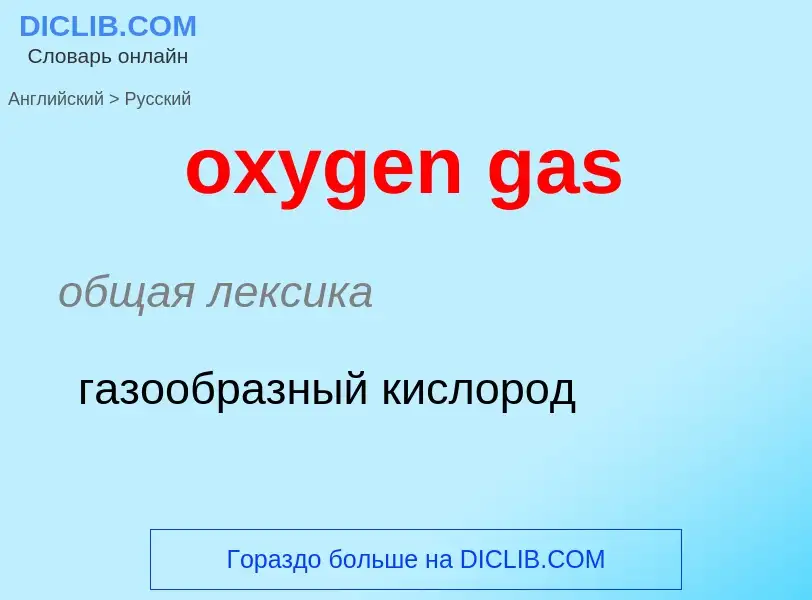Vertaling en analyse van woorden door kunstmatige intelligentie ChatGPT
Op deze pagina kunt u een gedetailleerde analyse krijgen van een woord of zin, geproduceerd met behulp van de beste kunstmatige intelligentietechnologie tot nu toe:
- hoe het woord wordt gebruikt
- gebruiksfrequentie
- het wordt vaker gebruikt in mondelinge of schriftelijke toespraken
- opties voor woordvertaling
- Gebruiksvoorbeelden (meerdere zinnen met vertaling)
- etymologie
oxygen gas - vertaling naar russisch
общая лексика
газообразный кислород
общая лексика
свободный кислород
общая лексика
чистый кислород
Definitie
Wikipedia

Oxygen is the chemical element with the symbol O and atomic number 8. It is a member of the chalcogen group in the periodic table, a highly reactive nonmetal, and an oxidizing agent that readily forms oxides with most elements as well as with other compounds. Oxygen is Earth's most abundant element, and after hydrogen and helium, it is the third-most abundant element in the universe. At standard temperature and pressure, two atoms of the element bind to form dioxygen, a colorless and odorless diatomic gas with the formula O
2. Diatomic oxygen gas currently constitutes 20.95% of the Earth's atmosphere, though this has changed considerably over long periods of time. Oxygen makes up almost half of the Earth's crust in the form of oxides.
All plants, animals, and fungus need oxygen for cellular respiration, which extracts energy by the reaction of oxygen with molecules derived from food and produces carbon dioxide as a waste product. In tetrapods breathing brings oxygen into the lungs where gas exchange takes place, carbon dioxide diffuses out of the blood, and oxygen diffuses into the blood. The body's circulatory system transports the oxygen the cells, where cellular respiration takes place.
Many major classes of organic molecules in living organisms contain oxygen atoms, such as proteins, nucleic acids, carbohydrates, and fats, as do the major constituent inorganic compounds of animal shells, teeth, and bone. Most of the mass of living organisms is oxygen as a component of water, the major constituent of lifeforms. Oxygen is continuously replenished in Earth's atmosphere by photosynthesis, which uses the energy of sunlight to produce oxygen from water and carbon dioxide. Oxygen is too chemically reactive to remain a free element in air without being continuously replenished by the photosynthetic action of living organisms. Another form (allotrope) of oxygen, ozone (O
3), strongly absorbs ultraviolet UVB radiation and the high-altitude ozone layer helps protect the biosphere from ultraviolet radiation. However, ozone present at the surface is a byproduct of smog and thus a pollutant.
Oxygen was isolated by Michael Sendivogius before 1604, but it is commonly believed that the element was discovered independently by Carl Wilhelm Scheele, in Uppsala, in 1773 or earlier, and Joseph Priestley in Wiltshire, in 1774. Priority is often given for Priestley because his work was published first. Priestley, however, called oxygen "dephlogisticated air", and did not recognize it as a chemical element. The name oxygen was coined in 1777 by Antoine Lavoisier, who first recognized oxygen as a chemical element and correctly characterized the role it plays in combustion.
Common uses of oxygen include production of steel, plastics and textiles, brazing, welding and cutting of steels and other metals, rocket propellant, oxygen therapy, and life support systems in aircraft, submarines, spaceflight and diving.







![Oxygen and [[MAPP gas]] compressed-gas cylinders with regulators Oxygen and [[MAPP gas]] compressed-gas cylinders with regulators](https://commons.wikimedia.org/wiki/Special:FilePath/Compressed gas cylinders.mapp and oxygen.triddle.jpg?width=200)




![[[Space-filling model]] representation of dioxygen (O<sub>2</sub>) molecule [[Space-filling model]] representation of dioxygen (O<sub>2</sub>) molecule](https://commons.wikimedia.org/wiki/Special:FilePath/Oxygen molecule.png?width=200)



![2}} is used in [[space suit]]s. 2}} is used in [[space suit]]s.](https://commons.wikimedia.org/wiki/Special:FilePath/STS057-89-067 - Wisoff on the Arm (Retouched).jpg?width=200)



